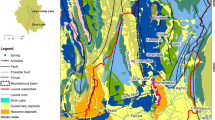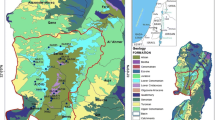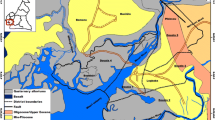Abstract
As groundwater becomes an increasingly important water resource worldwide, it is essential to understand how local geology affects groundwater quality, flowpaths and residence times. This study utilized multiple tracers to improve conceptual and numerical models of groundwater flow in the Middle San Pedro Basin in southeastern Arizona (USA) by determining recharge areas, compartmentalization of water sources, flowpaths and residence times. Ninety-five groundwater and surface-water samples were analyzed for major ion chemistry (water type and Ca/Sr ratios) and stable (18O, 2H, 13C) and radiogenic (3H, 14C) isotopes, and resulting data were used in conjunction with hydrogeologic information (e.g. hydraulic head and hydrostratigraphy). Results show that recent recharge (<60 years) has occurred within mountain systems along the basin margins and in shallow floodplain aquifers adjacent to the San Pedro River. Groundwater in the lower basin fill aquifer (semi confined) was recharged at high elevation in the fractured bedrock and has been extensively modified by water-rock reactions (increasing F and Sr, decreasing 14C) over long timescales (up to 35,000 years BP). Distinct solute and isotope geochemistries between the lower and upper basin fill aquifers show the importance of a clay confining unit on groundwater flow in the basin, which minimizes vertical groundwater movement.
Résumé
L’eau souterraine devenant une ressource d’importance croissante à travers le monde, il est essentiel de comprendre comment la géologie locale affecte la qualité de l’eau souterraine, l’organisation des écoulements et les temps de séjour. Cette étude a utilisé des traceurs multiples pour améliorer les modèles d’écoulement souterrain conceptuel et numérique dans le Bassin Moyen de San Pedro, Sud-Est de l’Arizona (USA), en déterminant les aires de recharge, la compartimentation des venues d’eau, l’organisation des écoulements et les temps de séjour. Quatre-vingt quinze échantillons d’eau souterraine et d’eau de surface ont été analysés pour la chimie des ions majeurs (type d’eau et ratios Ca/Sr), isotopes stables (18O, 2H, 13C) et radiogéniques (3H, 14C), et les données résultantes utilisées en conjonction avec les données hydrogéologiques (e.g. charge hydraulique et hydro stratigraphie). Les résultats montrent que la recharge récente (<60 ans) a lieu dans les systèmes montagneux le long des marges du bassin et dans des aquifères peu profonds de plaine d’inondation le long de la rivière San Pedro. L’aquifère du bassin inférieur (semi-captif) est rechargé à une cote élevée dans le substrat fracturé et considérablement modifié par des réactions eau-roche (accroissement de F et Sr, décroissance du14C) sur de longues périodes de temps (jusqu’à 35 000 ans avant l’actuel). Les différences géochimiques des solutés et des isotopes entre le remplissage des aquifères des bassins supérieur et inférieur montrent l’importance de l’unité argileuse «confinante» sur les écoulements souterrains dans le bassin, qui minimise les mouvements verticaux de l’eau souterraine.
Resumen
Puesto que el agua subterránea se convierte en un recurso de agua crecientemente más importante en todo el mundo, es esencial entender como la geología local afecta la calidad del agua subterránea, las trayectorias de flujo y los tiempos de residencias. Este estudio utilizó múltiples trazadores para mejorar los modelos conceptuales y numéricos del flujo de agua subterránea en la cuenca de Middle San Pedro en el sudeste de Arizona (EEUU) determinando las área de recarga, la compartimentación de las fuentes de agua, las trayectorias de flujo y los tiempos de residencia. Se analizaron noventa y cinco muestras de agua subterránea y de agua superficial en la búsqueda de los iones químicos principales (tipo de agua y relaciones Ca/Sr) e isótopos estables (18O, 2H, 13C) y radiogénicos (3H, 14C), y los datos resultantes fueron usados en conjunción con la información hidrogeológica (por ejemplo carga hidráulica e hidroestratigrafía). Los resultados muestran que ha ocurrido una recarga reciente (<60 años) dentro de los sistemas montañosos a lo largo de los márgenes de cuenca y en los acuíferos someros de la planicie de inundación adyacente al Río San Pedro. El agua subterránea en los acuíferos de relleno (semiconfinados) de la cuenca inferior fue recargada en las altas elevaciones en las rocas fracturadas del basamento y ha sido extensamente modificada por las reacciones agua – roca (incrementándose el F y Sr, y disminuyendo el 14C) a lo largo de grandes escalas de tiempo (hasta 35,000 años antes del presente). La geoquímica de distintos solutos y los isótopos en los acuíferos de relleno en la cuenca inferior y superior muestran la importancia de una unidad arcillosa confinante sobre el flujo de agua subterránea en la cuenca, lo que minimiza el movimiento vertical del agua subterránea.
Resumo
À medida que a água subterrânea se torna progressivamente num importante recurso hídrico à escala mundial, é essencial perceber-se como a geologia local afeta a qualidade da água subterrânea, os caminhos de fluxo e os tempos de residência. Este estudo utilizou múltiplos traçadores para melhorar os modelos conceptuais e numéricos do fluxo de água subterrânea na Bacia Média de San Pedro, no sudeste do Arizona (EUA), através da determinação das áreas de recarga, da compartimentação das origens da água, dos caminhos de fluxo e dos tempos de residência. Foram analisadas noventa e cinco amostras de água subterrânea e superficial para o quimismo dos iões principais (tipos de água e rácios Ca/Sr), os isótopos estáveis (18O, 2H, 13C) e os radiogénicos (3H, 14C), tendo os dados resultantes sido usados em conjugação com informação hidrogeológica (p. ex. carga hidráulica e hidrostratigrafia). Os resultados mostram que a recarga recente (<60 anos) ocorreu nos sistemas montanhosos ao longo das margens da bacia e nas planícies de cheia baixas, adjacentes ao rio San Pedro. A água subterrânea no aquífero inferior do enchimento da bacia (semi-confinado) foi recarregada a cotas superiores no embasamento rochoso fraturado e foi extensivamente modificada por reações água-rocha (aumento de F e Sr, decréscimo de 14C) ao longo de extensas escalas temporais (até 35,000 anos antes do presente). As distintas geoquímicas dos solutos e dos isótopos entre os aquíferos superiores e inferiores no enchimento da bacia mostram a importância de uma unidade confinante de argila no fluxo de água subterrânea na bacia, a qual minimiza a movimentação vertical da água subterrânea.














Similar content being viewed by others
References
Anderson TW, Freethey GW, Tucci P (1992) Geohydrology and water resources of alluvial basins in south-central Arizona and parts of adjacent states. US Gov. Printing Office, Washington, DC, p 1406-B
Arizona Daily Star (2005) Growth crawls toward Benson. Arizona Daily Star newspaper article published March 27, 2005. http://www.dailystar.com/. Accessed July 25, 2005
Arizona Department of Water Resources (2005) Upper San Pedro Basin active management area review report. Arizona Department of Water Resources, Phoenix, AZ. http://www.azwater.gov/azdwr/. Accessed January 26, 2009
Auken E, Jørgensen F, Sørensen KI (2003) Large-scale TEM investigation for groundwater. Explor Geophys 34:188–194
Baillie MN, Hogan JF, Ekwurzel B, Wahi AK, Eastoe CJ (2007) Quantifying water sources to a semiarid riparian ecosystem, San Pedro River, Arizona. J Geophys Res 112(G3), G03S02
Burtell RT (1989) Geochemistry and occurrence of ground water in the Allen Flat Basin, Arizona. MSc Thesis, University of Arizona, USA
Coes A (1997) A geochemical approach to determine ground-water flow patterns in the Sierra Vista basin, Arizona, with special emphasis on ground-water/surface-water interaction. MSc Thesis, University of Arizona, USA
Coes A, Pool D (2007) Ephemeral-stream channel and basin-floor infiltration and recharge in the Sierra Vista subwatershed of the Upper San Pedro Basin, southeastern Arizona. US Geol Surv Prof Pap 1703-J, pp 253–311
Coleman ML, Moore MP (1978) Direct reduction of sulfates to sulfur dioxide for isotopic analysis. Anal Chem 50:1594–1598
Craig H (1957) Isotopic standards for carbon and oxygen and correction factors for mass spectrometric analysis of carbon dioxide. Geochem Cosmochim Acta 12:133–149
Dickinson WR (1991) Tectonic setting of faulted Tertiary strata associated with the Catalina core complex in southern Arizona. Geol Soc Am Spec Pap 264, 106 pp
Dickinson JE, Hanson RT, Ferre TPA, Leake SA (2004) Inferring time-varying recharge from inverse analysis of long-term water levels. Water Resour Res 40, W07403
Dickinson JE, Kennedy JR, Cordova JT, Parker JT, Macy JP, Blakemore T (2010a) Hydrogeologic framework of the Middle San Pedro watershed, southeastern Arizona. US Geol Surv Sci Invest Rep 2010-5126, 36 pp
Dickinson JE, Pool DR, Groom RW, Davis LJ (2010b) Inference of lithologic distributions in an alluvial aquifer using airborne transient electromagnetic surveys. Geophysics 75:WA149–WA161
Earman S, McPherson BJOL, Phillips FM, Ralser S, Herrin JM, Broska J (2008) Tectonic influences on ground water quality: insight from complementary methods. Ground Water 46(3):354–371
Eastoe CJ, Gu A, Long A (2004) The origins, ages, and flow paths of groundwater in Tucson Basin: results of a study of multiple isotope systems. In: Hogan JF, Phillips FM, Scanlon BR (eds) Groundwater recharge in a desert environment: the southwestern United States. Am Geophys Union, Washington, DC, pp 217–234
Eastoe CJ, Watts CJ, Ploughe M, Wright WE (2011) Future use of tritium in mapping pre-bomb groundwater volumes. Ground Water 50(1):87–93
Eastoe CJ, Watts CJ, Ploughe M, Wright WE (2012) Future use of tritium in mapping pre-bomb groundwater volumes. Ground Water 50(1):87–93
Edmunds WM, Smedley PL (2000) Residence time indicators in groundwater: the East Midlands Triassic Sandstone Aquifer. Appl Geochem 15:737–752
Fenneman NM (1931) Physiography of western United States, 1st edn. McGraw–Hill, New York
Fordyce FM, Vrana K, Zhovinsky E, Povoroznuk V, Toth G, Hope BC, Iljinsky U, Baker J (2007) A health risk assessment for fluoride in Central Europe. Environ Geochem Health 29:83–102
Freethey GW (1982) Hydrologic analysis of the Upper San Pedro Basin from the Mexico-United States boundary to Fairbank, Arizona. US Geol Surv Open-File Rep 82-752
Gehre M, Hoefling R, Kowski P, Strauch G (1996) Sample preparation device for quantitative hydrogen isotope analysis using chromium metal. Anal Chem 68:4414–4417
Gieskes JM, Rogers CW (1973) Alkalinity determination in interstitial waters of marine sediments. J Sediment Petrol 43:272–277
Goode TC, Maddock T III (2000) Simulation of groundwater conditions in the Upper San Pedro Basin for the evaluation of alternative futures. HWR No. 00-030, University of Arizona, Tuscon, AZ, 113 pp
Huckleberry G (1996) Historical changes on the San Pedro River, southeastern Arizona. Open-file report 96-15, Arizona Geological Survey, Tuscon, AZ
Jacks G, Bhattacharya P, Chaundhary V, Singh KP (2005) Controls on the genesis of some high-fluoride groundwaters in India. Appl Geochem 20:221–228
Larsen D, Gentry RW, Solomon DK (2003) The geochemistry and mixing of leakage in a semi-confined aquifer at a municipal well field, Memphis, Tennessee, USA. Appl Geochem 18(7):1043–1063
Leake SA, Reeves HW, Dickinson JE (2010) A new capture fraction method to map how pumpage affects surface water flow. Ground Water 48(5):690–700
McDonald MG, Harbaugh AW (1988) A modular three-dimensional finite-difference ground-water flow model. US Dept. of the Interior, Reston, VA
McPherson GR, Boutton TW, Midwood AJ (1993) Stable carbon isotope analysis of soil organic matter illustrates vegetation change at the grassland/woodland boundary in southeastern Arizona, USA. Oecologia 93:95–101
Plummer NL, Prestemon EC, Parkhurst DL (1994) An interactive code (NETPATH) for modeling NET geochemical reactions along a flow PATH version 2.0. US Geol Surv Open-File Rep 94-4169
Plummer NL, Bexfield LM, Anderholm SK, Sanford WE, Busenberg E (2004) Hydrochemical tracers in the Middle Rio Grande Basin, USA: conceptualization of groundwater flow. Hydrogeol J 12:359–388
Pollock DW (1994) MODPATH a particle tracking post-processing model for MODFLOW. US Geol Surv Open-File Rep 94-463
Pool DR, Coes AL (1999) Hydrogeologic investigations of the Sierra Vista Subwatershed of the Upper San Pedro Basin, Cochise County, southeast Arizona. US Geol Surv Water Resour Invest Rep 99-4197
Robertson FN (1989) Arsenic in ground-water under oxidizing conditions, South-West United States. Environ Geochem Health 11:171–185
Robertson FN (1991) Geochemistry of ground water in alluvial basins of Arizona and adjacent parts of Nevada, New Mexico, and California. US Geol Surv Prof Pap 1406-C
Robertson FN (1992) Radiocarbon dating of groundwater in a confined aquifer in southeast Arizona. Radiocarbon 34:664–676
Roeske RH, Werrell WL (1971) Hydrologic conditions in the San Pedro River Valley, Arizona. Bull 4, Arizona Water Commission, Phoenix, AZ, 76 pp
Sanford WE, Plummer LN, McAda DP, Bexfield LM, Anderholm SK (2004) Hydrochemical tracers in the middle Rio Grande Basin, USA: 2. calibration of a groundwater-flow model. Hydrogeol J 12:389–407
Simpson SC (2007) Modeling stream-aquifer interactions during floods and baseflow: Upper San Pedro River, southeastern Arizona. MSc Thesis, University of Arizona, USA
Theodorsson P (1996) Low-level counting: past - present - future. Appl Radiat Isot 47(9/10):827–834
US Geological Survey (variously dated) National field manual for the collection of water-quality data. US Geological Survey Techniques of Water-Resources Investigations, book 9, chaps. A1–A9. http://pubs.water.usgs.gov/twri9A. Accessed September 26, 2008
Usunoff EJ (1984) Hydrochemistry of the San Pedro River Basin near Saint David, Cochise County, Arizona, with special emphasis on the behavior of fluoride. MSc Thesis, University of Arizona, USA
Wahi AK, Hogan JF, Ekwurzel B, Eastoe CJ (2008) Geochemical quantification of semiarid mountain recharge. Ground Water 46:414–425
Western Regional Climate Center (2009) Historical data. http://www.wrcc.dri.edu/. Accessed June 10, 2009
Zhu C, Waddell RK, Star I, Ostrander M (2010) Responses of ground water in the Black Mesa basin, northeastern Arizona, to paleoclimactic changes during the late Pleistocene and Holocene. Geology 38:83–86
Acknowledgements
The landowners and citizens of the Middle San Pedro Basin, Arizona, are thanked for their assistance with this study. Funding for this project was provided by the Arizona Department of Water Resources Rural Watershed Initiative, the USGS Arizona Water Science Center, and the University of Arizona. Many thanks to the USGS reviewers who contributed to this report.
Author information
Authors and Affiliations
Corresponding authors
Rights and permissions
About this article
Cite this article
Hopkins, C.B., McIntosh, J.C., Eastoe, C. et al. Evaluation of the importance of clay confining units on groundwater flow in alluvial basins using solute and isotope tracers: the case of Middle San Pedro Basin in southeastern Arizona (USA). Hydrogeol J 22, 829–849 (2014). https://doi.org/10.1007/s10040-013-1090-0
Received:
Accepted:
Published:
Issue Date:
DOI: https://doi.org/10.1007/s10040-013-1090-0




